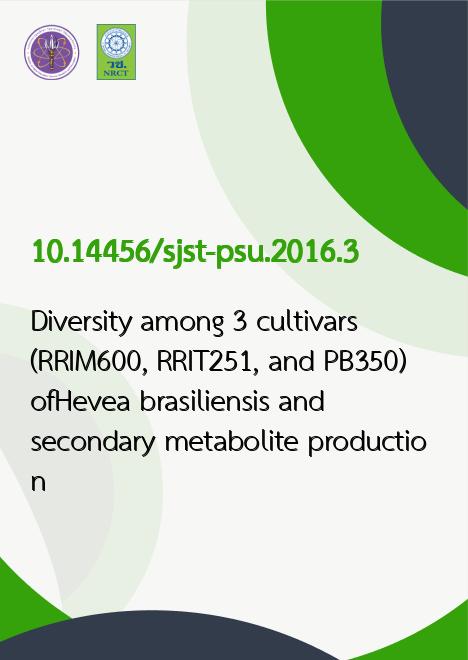
|
Diversity among 3 cultivars (RRIM600, RRIT251, and PB350) ofHevea brasiliensis and secondary metabolite production |
|---|---|
| รหัสดีโอไอ | |
| Creator | 1. Rugchanok Puwaphut 2. Alisa Nakkaew 3. Amornrat Phongdara |
| Title | Diversity among 3 cultivars (RRIM600, RRIT251, and PB350) ofHevea brasiliensis and secondary metabolite production |
| Publisher | Research and Development Office, Prince of Songkla University |
| Publication Year | 2559 |
| Journal Title | Songklanakarin Journal of Science and Technology (SJST) |
| Journal Vol. | 38 |
| Journal No. | 1 |
| Page no. | 15-22 |
| Keyword | Hevea brasiliensis,internal transcribed spacer (ITS),9-octadecanoic acid (Z),methyl ester,hexadecanoic acid,methyl ester,2-furancarboxaldehyde-5-(hydroxymethyl) |
| ISSN | 0125-3395 |
| Abstract | Hevea brasiliensis was introduced to Thailand for the production of natural rubber. RRIT251 and RRIM600 are highyield varieties while PB350 produces a high yield of latex and resistance to diseases. The cultivar identity must be ascertained prior to plantation establishment because it is important to relate the genetic background with the production of certain secondary metabolites. In this study, the internal transcribed spacer region was used to evaluate the varieties among these 3 cultivars. Callus induction was initiated with 2 mg/L 2,4-dichlorophenoxyacetic acid (2,4-D) and 2 mg/L 6-benzylaminopurine (BAP). Hexadecanoic acid, methyl ester and 9-octadecanoic acid (Z), methyl ester were detected in RRIM600 calli. 2-Furancarboxaldehyde-5-(hydroxymethyl) was dominant in the RRIT251 and PB350 calli. These secondary metabolites are relevant in various high performance commercial sectors. |
